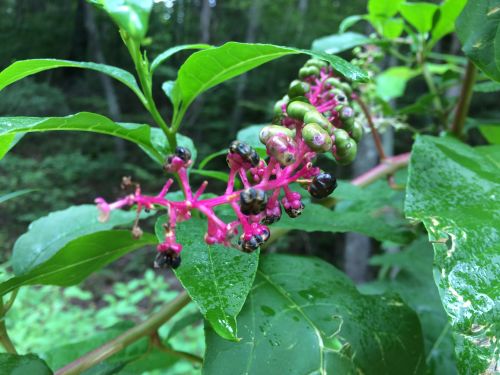How to Make Pokeberry Extract
★★★★★

We'd call poke salad a spring tonic we never ever got sick from any thing - stomach bugs flues fevers. so if poke's so toxic why are we all so healthy after eating it for yrs? How's your health?
Poke Herb Photos
★★★★★

Poke is tall now in TN; some plants are 6 feet tall!
This picture shows the bright magenta berry stem. Most of these berries have been picked clean by the birds. They will digest all but the seeds and then pass the seeds along for new poke plants next spring. The seed is the most dangerous part.
The green berries are not ripe. The deep purple berries are ripe. Some people will swallow a berry a day and let the seed pass through (the seed is the most toxic part, other than the root.) The berry a day is for arthritis.
Poke root tincture is used by some for Lyme disease, a DROP at a time. (Not a dropperful.)
Poke root oil is used for breast tumors.
In the spring the leaves used to be boiled in three changes of water for a "tonic" food. If the plant is taller than a foot, the plants are too old to harvest the leaves, so they say.
Poke berries make a fun homemade ink for children, with supervision of course.
Poke is a perfect example of "the dose makes the poison." Poke is classified as poisonous, but when used carefully by those who know what they are doing it can be a great benefit.
~Mama to Many~


Gout and Joint Pains
★★★★★

Pick your pokeberries (poke sallet) next fall. Great for all joint pains. My brother had a bad attack of gout and hobbling with a walker. Said doctor told him he would have to live with it because he had nothing else to try. Picked him a bag of ripe pokeberries and carried to him. Had a little trouble in talking him into eating asparagus also, because he said the doctor told him it was bad for the gout. My reply was it was bad for the gout but it was good for him. Two days later with about 15 to 20 pokeberries 4 times per day and plenty of asparagus, he was walking without limping, without pain and without the walker.
When you have a bumper crop of pokeberries, just dehydrate the excess that you can't use while fresh and ripe. For those who want to get more sophisticated and make a pokeberry tincture or extract, just google "how do I make a herbal extract or tincture. Basic rule of thumb is two most common diluents is alcohol and vinegar. Fresh herb is equal parts of herb to diluent. Using dehydrated herb use ratio of 2 parts diluent to one part dehydrated herb.
How to Make Pokeberry Extract
★★★★★

"To Joyce from Joelton,Tn. Gout: What is the method used with Pokeweed for Gout? Do you make a paste and wrap the foot, or do you ingest them? Please advise? What are the exact measurements for this herb?"
I started doing this by putting berries in l gallon jug and using enough Vodka to just cover the berries. Put tight lid on and let set a week or two, moving jug around a little every two to three days. After that, just strain off the liquid and store in brown or green bottles. Beer bottles work fine for storage. (You can also use your potato masher (or whatever you have) to kind of sqush those pokeberries before straining the liquid off.
For those of you who are interested in doing your own herbs, when using fresh herbs your ratio is l:l. If using dehydrated herbs the ratio is l part herb to 2 parts diluent.
I can't remember where I read it, but I do recall reading that you shouldn't treat children under l2 with poke, because it hastened the setting of the long bones (arms & legs). There might be something to this because my family ate a lot of poke sallet and many of us have normal size bodies but short arms and legs. I might also add that most references recommend parboiling through 3 waters before ingesting, but my family (and others that I know who ate their share of it) only parboiled through one water (water discarded) before proceeding to finish cooking it and eating it.



